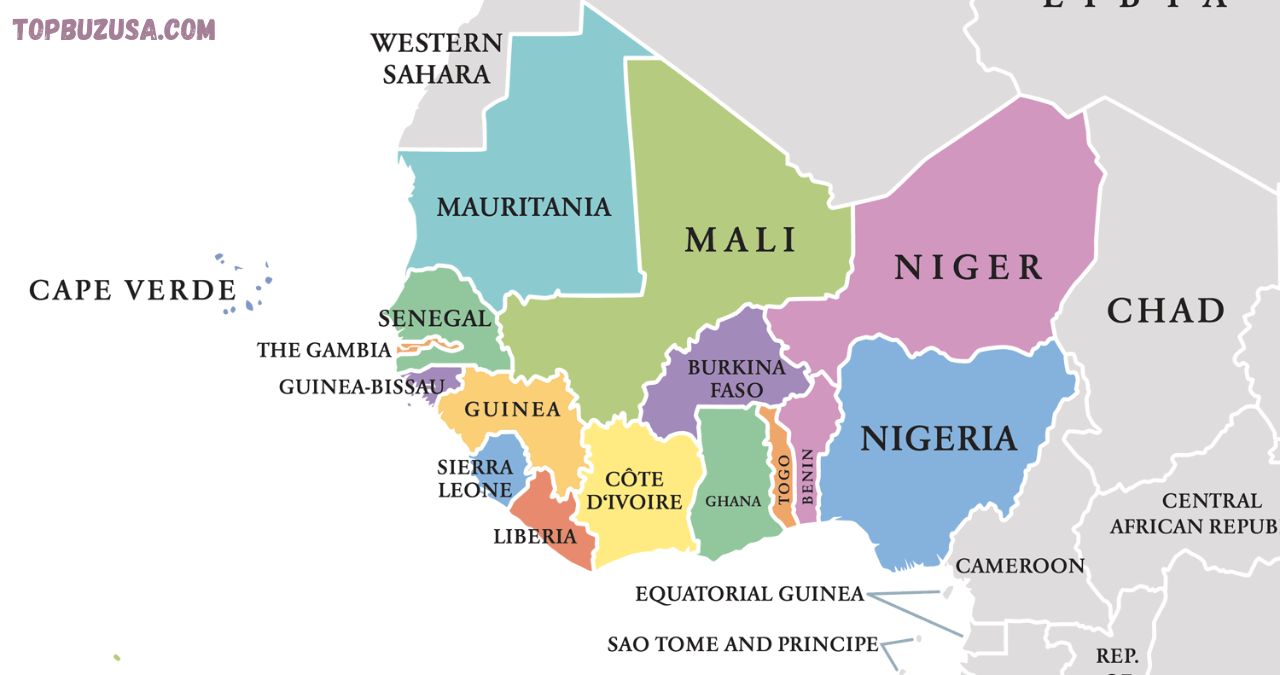Introduction
West Africa Map is a captivating region of the African continent, characterized by its rich cultural diversity, historical significance, and complex geography. Situated in the western part of Sub-Saharan Africa, this region comprises numerous countries with distinct identities yet shared experiences. The map of West Africa Map is more than just a collection of lines and boundaries; it is a living narrative of ancient civilizations, colonial legacies, and modern-day political dynamics. Understanding the geography and mapping of West Africa Map is vital for appreciating its current challenges and opportunities.
This article offers a comprehensive exploration of West Africa Map through its map. From natural landscapes and climate zones to national boundaries and cityscapes, we delve into every aspect that defines this significant part of the world. Whether you’re a student, traveler, researcher, or simply curious about African geography, this deep dive into the West African map aims to inform and inspire. By the end, you will have a clearer perspective on the geopolitical and environmental layout of this crucial African region.
Understanding the Geographic Boundaries of West Africa Map
West Africa Map is strategically positioned on the western edge of the African continent, bordered by the Atlantic Ocean to the south and west. To the north lies the arid Sahara Desert, while to the east, it shares gradual transitions with Central Africa. This positioning makes West Africa a bridge between North Africa’s Arab influences and the tropical cultures of Sub-Saharan Africa. It occupies a significant portion of Africa’s landmass, contributing to its economic and political weight on the continent.
West Africa’s geographic layout includes a variety of terrains and ecosystems, from coastal lowlands to inland plateaus. Countries like Nigeria and Ghana are coastal and benefit from maritime trade, while landlocked nations like Burkina Faso and Mali face different development challenges. The region’s geography plays a crucial role in shaping its agricultural practices, transportation networks, and urbanization trends.
Natural Borders and Landforms
The natural features of West Africa serve not only as geographical landmarks but also as historical and cultural dividers. The Niger River, one of Africa’s major waterways, traverses several West African countries, providing water for agriculture, transportation, and human settlement. Another key feature is the Sahel, a semi-arid zone that transitions between the Sahara Desert and the more fertile southern regions. This area has historically hosted nomadic communities and faces challenges such as desertification and climate change.
Mountain ranges like the Fouta Djallon highlands in Guinea and the Jos Plateau in Nigeria add to the topographical diversity. These landforms influence weather patterns and serve as watersheds for major rivers. Coastal countries such as Senegal and Ivory Coast boast extensive shorelines, facilitating trade and tourism. Understanding these natural features is essential for interpreting the map and appreciating the diverse environments of West Africa.
Climate and Environmental Zones
West Africa is marked by a wide range of climate zones, from arid deserts in the north to lush rainforests in the south. These zones greatly affect agricultural outputs, human settlement patterns, and economic activities. The northern parts of the region are dominated by the Sahel and Sahara Desert, characterized by low rainfall and extreme temperatures. These areas are prone to droughts and have limited arable land.
In contrast, the southern parts of West Africa Map receive ample rainfall, especially during the wet season, supporting dense forests and fertile soils. Countries like Liberia and Sierra Leone enjoy a tropical rainforest climate, conducive to crops like cocoa, rubber, and palm oil. The climate diversity across the region presents both opportunities and challenges in terms of food security, biodiversity conservation, and sustainable development.
Countries of West Africa
West Africa Map is composed of 16 countries, many of which are members of the Economic Community of West African States (ECOWAS). These countries include Nigeria, Ghana, Senegal, Ivory Coast, Burkina Faso, Mali, Niger, Togo, Benin, Guinea, Sierra Leone, Liberia, The Gambia, Cape Verde, Guinea-Bissau, and Mauritania. Each of these nations has unique geographical features, cultural practices, and developmental priorities.
Nigeria is the most populous country in Africa and serves as a regional powerhouse in terms of economy and politics. Ghana and Senegal are often highlighted for their stable democracies and growing economies. Meanwhile, landlocked countries like Niger and Mali face logistical and environmental challenges that hinder their development. Mapping each country’s capital, population, and major cities provides a clearer picture of West Africa’s demographic landscape.
Political and Historical Groupings
The political borders seen on today’s maps of West Africa Map are largely the result of European colonization. During the late 19th and early 20th centuries, countries like France, Britain, and Portugal carved up the region without regard for existing ethnic or cultural boundaries. This colonial past still influences contemporary politics and border dynamics.
Francophone countries such as Senegal and Ivory Coast share similar legal and educational systems, while Anglophone nations like Ghana and Nigeria have different administrative frameworks. Lusophone countries like Guinea-Bissau and Cape Verde further diversify the region’s colonial heritage. Understanding these groupings is crucial for interpreting the cultural and linguistic diversity that exists within the political borders.
Border Disputes and Regional Tensions
Although the borders on the West African map appear fixed, several are subject to dispute. One notable example is the Bakassi Peninsula conflict between Nigeria and Cameroon, which was resolved by the International Court of Justice but remains sensitive. There are also internal conflicts driven by ethnic tensions and resource competition, often exacerbated by colonial-era boundaries.
ECOWAS plays a key role in mediating such disputes and fostering regional stability. The organization promotes cooperation among member states, enabling peaceful resolutions and joint development initiatives. Understanding border dynamics is essential for grasping the complexities of regional governance and conflict in West Africa.
Major Cities and Landmarks on the Map

Major urban centers are focal points on any map of West Africa Map. Cities such as Lagos (Nigeria), Accra (Ghana), Abidjan (Ivory Coast), and Dakar (Senegal) are not only political capitals but also economic engines. Lagos, for instance, is one of the largest cities in the world by population and plays a critical role in trade, finance, and culture.
These cities are strategically located along coastlines or major rivers, enabling efficient transport and access to global markets. They attract internal migration, contributing to rapid urbanization and infrastructure challenges. Mapping these urban centers helps understand regional economic trends and development hotspots.
Cultural and Historical Landmarks
West Africa is home to a wealth of cultural and historical landmarks that can be identified on regional maps. The ancient city of Timbuktu in Mali, once a center of Islamic scholarship, is a UNESCO World Heritage Site. Ghana’s Cape Coast Castle is a somber reminder of the transatlantic slave trade.
These landmarks not only offer insights into the region’s past but also attract tourists and scholars. Accurate mapping of these sites is essential for cultural preservation and tourism development. They also serve as symbols of resilience and identity for West Africa Map communities.
Transportation and Trade Corridors
Transport infrastructure is a vital component of West Africa’s map. Major highways like the Trans-West African Coastal Highway link multiple countries and facilitate the movement of goods and people. Key railways and inland waterways further enhance regional connectivity.
Ports in Lagos, Abidjan, and Tema serve as maritime gateways, while airports in major cities support international travel and commerce. Mapping these corridors reveals the economic lifelines of the region and underscores the importance of cross-border cooperation in infrastructure development.
Strategic Importance of Mapping West Africa Map
The map of West Africa is a powerful tool for understanding the distribution of natural resources such as oil, gold, cocoa, and bauxite. These resources are unevenly distributed, affecting the economic strategies of different countries. Nigeria’s oil-rich Niger Delta, Ghana’s gold mines, and Ivory Coast’s cocoa plantations are critical to their respective economies.
Maps help governments and investors identify areas of opportunity and need. They guide infrastructure projects, disaster preparedness, and urban planning. Accurate geographic information systems (GIS) are increasingly used to support development planning and monitor resource usage in West Africa Map.
Security and Governance
Security challenges in West Africa Map, including terrorism, piracy, and smuggling, are closely tied to geography. Border areas are often difficult to monitor, providing cover for illicit activities. Mapping hotspots of insecurity enables better deployment of resources and coordination among security agencies.
Governance also benefits from accurate mapping. Electoral districts, service delivery zones, and administrative boundaries must be clearly delineated for effective policy implementation. Maps contribute to transparency and accountability in public administration.
Education and Tourism
Maps play an essential role in education, helping students understand their world and fostering geographic literacy. In West Africa Map, improving map-based education can enhance awareness of national and regional identities, environmental issues, and civic responsibility.
Tourism also relies heavily on maps. Tourists need reliable information about landmarks, parks, and routes. Promoting digital mapping tools can support sustainable tourism while preserving natural and cultural heritage. A well-mapped region is more accessible and attractive to global visitors.
Conclusion
The map of West Africa Map tells a story of diversity, complexity, and potential. From the rugged terrains and sprawling cities to political borders and cultural landmarks, every feature contributes to a deeper understanding of the region. As West Africa Map continues to navigate challenges like climate change, security threats, and economic integration, the importance of accurate and comprehensive mapping cannot be overstated.
You May Also Read: https://topbuzusa.com/adeena-mendel/





